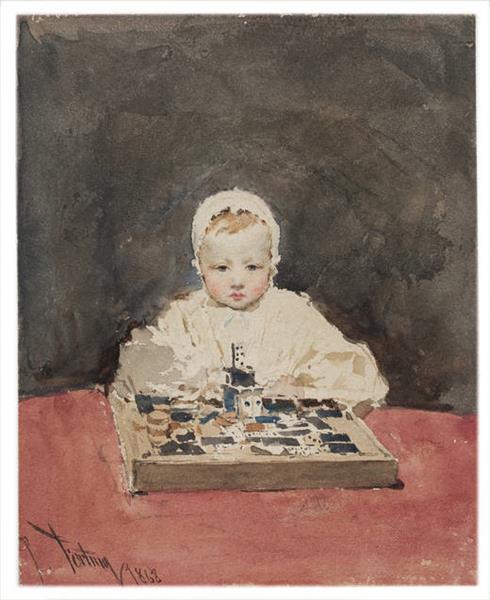Description
The work "María Teresa de Madrazo" by Mariano Fortuny is an outstanding example of the realistic and modern style that characterized the Spanish painter. Fortuny, known for his mastery in the representation of light and color, captures the essence of his model in a touching way, raising the portrait paint to new heights. In this work, carried out in 1860, Fortuny portrays María Teresa de Madrazo, a figure that, although not widely recognized in the history of art, becomes the central axis of the visual narrative of the fabric.
The use of color in this work is particularly remarkable. Fortuny demonstrates an exceptional domain over the palette, using soft tones that provide delicacy to the figure of María Teresa, contrasting with the darkest and subtly textured background. This contrast not only serves to enhance the figure, but also allows the viewer to focus on the details of the model's dress and face, which are both rich and nuanced. The light, which seems to illuminate the figure from a lateral angle, adds a three -dimensionality almost tangible to the forms, making the figure seem to come alive on the canvas.
From the compositional point of view, María Teresa's position is relaxed and natural, which gives an air of intimacy to the work. His expression manages to evoke a mixture of serenity and pensionivity, inviting the viewer to reflect on his inner world. The hair, elegantly arranged, frames his face in a way that highlights his features even more, making it the epicenter of the work. Fortuny also uses the arrangement of the body and the folds of the dress with precision that reflects his interest in naturalism, a distinctive feature of his work.
Investigating more about the portrayed figure, it is known that María Teresa de Madrazo was part of a prominent family of artists; His father, José de Madrazo, was an outstanding painter and director of the Prado Museum. Fortuny's choice to represent it not only highlights the importance of it as a model, but also underlines the value that the Madrazo family gave to the arts, at a time when romanticism began to give way to a greater focus on realism.
The historical context of this work is equally relevant. In the middle of the nineteenth century, Spain was in a transition stage, in which art was moving away from the past norms towards a more modern and personal approach. Fortuny, who had traveled to Italy and Morocco, sought to incorporate elements of these cultures in his work, which is partly observed in their dramatic use of light and detail attention in textiles.
The painting "María Teresa de Madrazo", in addition to being a portrait, becomes a testimony of Fortuny's technical ability and his ability to instill character and emotion in his work. The work is not only a portrait of a woman of her time, but also a reflection of the changes in the Spanish art of the nineteenth century, which are directed towards greater expressiveness and access to new themes and styles. This painting It invites the viewer to contemplate not only the beauty of the model, but also the cultural background that surrounds its existence, amalgamating the intimacy of the portrait with the vastness of art history. Fortuny's legacy as one of the great masters From his time he is still alive in his works, offering a bridge between the past and the innovations that would arise in the future.
KUADROS ©, a famous paint on your wall.
Hand-made oil painting reproductions, with the quality of professional artists and the distinctive seal of KUADROS ©.
Art reproduction service with satisfaction guarantee. If you are not completely satisfied with the replica of your painting, we refund your money 100%.

